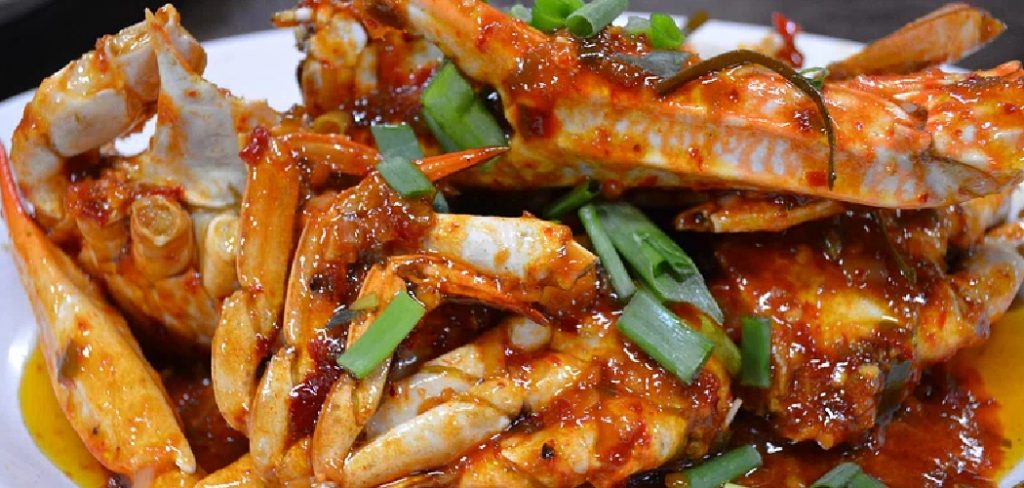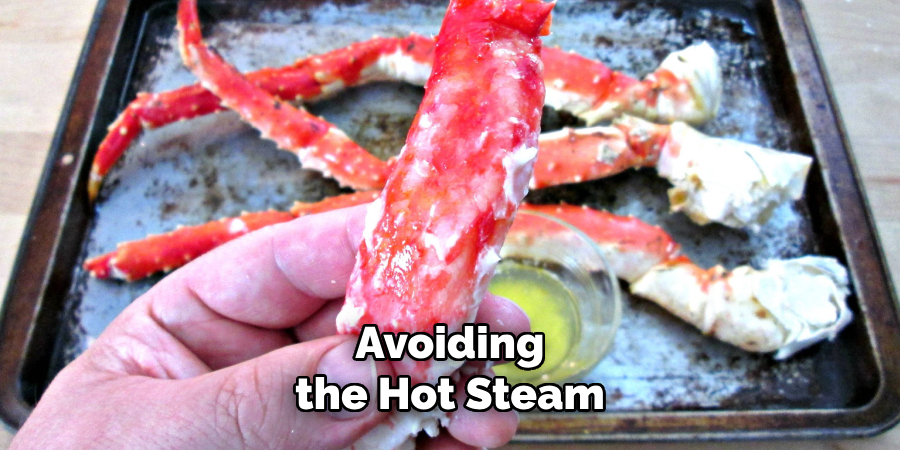Are you craving some delicious and succulent crab legs but don’t know how to prepare them in the oven? Look no further; this guide will teach you everything you need to know about steaming crab legs in the oven.

Steaming crab legs in oven is an excellent method that preserves their natural flavors and ensures they remain tender and juicy. This technique offers a more even heat distribution, allowing the crab legs to cook thoroughly without drying out. It is also a convenient and mess-free solution, eliminating the need for large pots of boiling water.
Additionally, this method reduces nutrient loss, helping to retain the essential vitamins and minerals found in seafood. Let’s get started on how to steam crab legs in oven!
What Will You Need?
To steam crab legs in the oven, you will need:
- Crab Legs
- Baking Sheet or Pan
- Aluminum Foil
- Butter (optional)
- Seasonings of your choice (optional)
- Lemon wedges (optional)
Make sure to purchase high-quality crab legs from a reputable source for the best results. You can also use fresh or frozen crab legs for this method.
8 Easy Steps on How to Steam Crab Legs in Oven
Step 1. Preheat Your Oven

Begin by preheating your oven to 400°F (200°C). This temperature is ideal for gently steaming the crab legs and ensuring they cook evenly. Preheating your oven is essential, as it helps create a consistent and warm environment for the crab legs as soon as they are placed inside. While the oven is preheating, you can take the time to prepare and arrange the crab legs for steaming. This preparation step ensures that the process will go smoothly and that the crab legs are perfectly cooked.
Step 2. Prepare the Crab Legs
If the crab legs are frozen, ensure they are fully thawed before cooking. You can thaw them by placing them in the refrigerator overnight or running them under cold water for a quicker method. Once thawed, rinse the crab legs under cool water to remove any ice crystals or debris. Pat them dry using a paper towel and arrange them on the baking sheet or pan. If desired, lightly coat the crab legs with melted butter and sprinkle your preferred seasonings to enhance their flavor.
Step 3. Steam the Crab Legs
Once the crab legs are prepared and arranged, place them in the oven. Pour a small amount of water—about 1/4 inch—into the bottom of the baking pan or sheet. This water will create steam as it heats, helping to keep the crab legs moist and flavorful during the cooking process. Cover the pan tightly with aluminum foil to trap the steam and maintain an even temperature. Allow the crab legs to steam in the oven for 10-15 minutes, depending on their size. Check that they are fully heated through before serving.
Step 4. Add Lemon Wedges

Once the crab legs are fully heated, carefully remove them from the oven, avoiding the hot steam as you peel back the aluminum foil. Gently transfer the crab legs to a serving platter using tongs or a spatula. Arrange fresh lemon wedges around the crab legs to enhance the presentation and flavor.
The acidity of the lemon juice complements the natural sweetness of the crab meat and adds a refreshing burst of flavor. Encourage your guests to squeeze the lemon wedges over their crab as desired. For an extra indulgence, you can also serve the crab legs with a side of melted butter or garlic butter for dipping. This combination creates a rich, savory experience that balances the moist, tender crab meat.
Step 5. Create a Dipping Sauce
Creating a delicious dipping sauce is the perfect way to elevate your crab leg feast and add a personalized touch to the meal. While melted butter is a classic choice, you can get creative by preparing a variety of sauces to suit different tastes. For a rich and garlicky option, mix melted butter with freshly minced garlic, a squeeze of lemon juice, and a pinch of parsley. If you prefer a spicy kick, consider making a tangy cocktail sauce by combining ketchup, horseradish, Worcestershire sauce, a splash of lemon juice, and a dash of hot sauce.
Alternatively, stir together mayonnaise, Dijon mustard, minced capers, and a hint of smoked paprika for a creamy and savory dip. No matter which sauce you choose, each option will complement the delicate flavor of the crab meat and provide a delightful contrast to its sweetness. Encourage your guests to experiment with different combinations to discover their favorite pairing.
Step 6. Keep Leftovers
If you have any leftover crab legs, you can store them in an airtight container and place them in the refrigerator. They will keep for up to three days, allowing you to enjoy the deliciousness of steamed crab legs even after your initial meal. When ready to eat, simply reheat the leftover crab legs by wrapping them in aluminum foil and placing them in a preheated oven at 350°F (175°C) for 8-10 minutes.
Step 7. Try Different Seasonings

Experimenting with different seasonings can elevate the flavor of your crab legs and create a unique culinary experience every time. While traditional options like Old Bay seasoning or garlic butter are always popular, you can also explore more adventurous combinations. For a zesty kick, sprinkle your crab legs with chili powder, smoked paprika, and a touch of cayenne pepper.
If you prefer a more herbal flavor profile, consider using fresh dill, parsley, and a squeeze of lemon juice. For those looking to infuse some international flair, try seasoning with a blend of soy sauce, ginger, and sesame oil for an Asian-inspired twist, or use a medley of Mediterranean herbs such as oregano, thyme, and rosemary. By experimenting with new tastes and combinations, you can uncover exciting variations that perfectly suit your preferences or impress your guests with your creativity in the kitchen.
Step 8. Serve and Enjoy
Once your crab legs are perfectly cooked and seasoned, it’s time to serve them. Arrange them on a large platter, accompanied by dipping sauces such as melted butter, garlic aioli, or a tangy cocktail sauce. Don’t forget to provide seafood crackers, picks, and plenty of napkins to make enjoying the meal hassle-free. Pair the crab legs with complementary sides like a fresh salad, crusty bread, or a light pasta dish to create a well-rounded dining experience. Finally, gather your family or friends, and savor the delicious flavors together—there’s no better way to enjoy this delectable seafood treat!
By following these steps, you can easily prepare and steam crab legs to perfection in the comfort of your own home.
5 Things You Should Avoid
- Skipping the Preheat Step: Always preheat your oven to ensure that it is even cooking. Placing the crab legs in a cold oven can result in unevenly steamed meat, leaving some parts undercooked and others overcooked.
- Using Too Little Water: Steaming requires the right amount of water. Using too little water can cause the pan to dry out, preventing the crab legs from properly steaming and potentially burning the pan.
- Overcrowding the Baking Dish: Avoid cramming too many crab legs into a single dish. Overcrowding restricts airflow and prevents steam from circulating evenly, resulting in inconsistent cooking.
- Skipping the Foil Cover: Not covering the baking dish with foil is a common mistake. The foil traps steam; without it, the crab legs will dry out instead of becoming tender and flavorful.
- Overcooking the Crab Legs: Steaming crab legs in the oven for too long can make the meat tough and rubbery. Stick to the recommended cooking time to keep the meat moist and perfectly cooked.
Is It Better to Bake or Steam Crab Legs?
Both baking and steaming are popular methods for cooking crab legs. However, the preferred method may vary depending on personal preference and desired outcome.
Baking is a dry heat method that produces a slightly firmer texture in the meat. This method is great for those who prefer a bit of bite to their crab legs or want to achieve a crispy exterior.
On the other hand, steaming is a moist heat method that results in tender and succulent crab meat. The steam helps to keep the meat moist and infuses it with flavor from any added seasonings or liquids.

Ultimately, both methods can produce delicious crab legs, so it comes down to personal preference. Some people even like combining both methods by partially baking the crab legs and finishing them with a quick steam. Experimenting with different cooking techniques can help you find your preferred way to prepare and enjoy crab legs.
Conclusion
How to steam crab legs in oven is a simple and effective way to achieve tender, flavorful results. Preheat your oven to 350°F and prepare a large baking dish to hold the crab legs.
Add a small amount of water, broth, or your preferred liquid to the dish, creating steam while cooking. Place the crab legs in the dish and cover them tightly with aluminum foil to seal the moisture. Bake for about 15-20 minutes, depending on the size of the crab legs, until heated.
This method allows the meat to retain its natural juices and enhances the flavors, making it a convenient and delicious way to prepare crab legs.
Professional Focus
Angela Ervin, a former interior designer turned blogger, specializes in kitchen design and renovations. Through her website, she blends her passion for cooking with design expertise, sharing practical and creative ideas. Known for balancing functionality and beauty, Angela’s insightful content has made her a trusted voice in home design and lifestyle.
About the Author
Angela Ervin, an experienced interior designer and blogger, combines her passion for kitchen renovations with storytelling. Living in Petersburg with her family, she enjoys cooking and testing her projects firsthand. Known for her humor and relatable style, Angela shares creative, functional design insights through her content, making her a trusted voice in home design.
Education History
University: Virginia Commonwealth University
Degree: Bachelor of Fine Arts (BFA) in Interior Design
- Angela’s education at VCU focused on mastering core interior design principles, including spatial planning, color theory, materials selection, and sustainable design practices.
- She gained hands-on experience through studio projects and collaborative design exercises, which honed her ability to create functional and aesthetically pleasing environments.
- Her coursework also emphasized problem-solving and practical applications of design, preparing her for real-world projects like her self-directed kitchen renovations.
- The program’s strong foundation in both technical skills and creative expression shaped Angela’s ability to seamlessly integrate form and function in her work.
